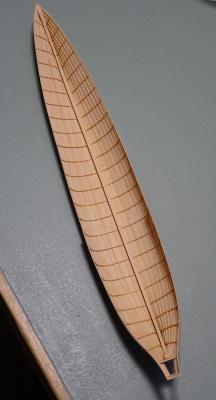-
Posts
13,355 -
Joined
-
Last visited
Content Type
Profiles
Forums
Gallery
Events
Everything posted by druxey
-
Certainly refining one joint at a time is a good strategy. Also gluing one joint at a time is. Multiple joints and you'll be chasing things around and almost guarantee failure. I personally don't use a jig, but rely on the two pieces I'm joining to line up perfectly on a copy of the assembly underneath. Also, watch out for creep and cumulative error as you build up a multi-part assembly. Adjust as necessary on - pardon the pun - the fly. Also, for model work, I've found power tools a snare and delusion. They always remove just a bit more than you want. But you know that already, right?
-
The discharge holes are usually circular, not square.
- 1,051 replies
-
- cheerful
- Syren Ship Model Company
-
(and 1 more)
Tagged with:
-
Endless: some contemporary models and plans do show the discharge tube exiting the counter. Looking great, Chuck!
- 1,051 replies
-
- cheerful
- Syren Ship Model Company
-
(and 1 more)
Tagged with:
-

ancre le rochefort by cabrapente
druxey replied to cabrapente's topic in - Build logs for subjects built 1751 - 1800
That's a flying start! You've a lot of pieces cut already. -
Looking lovely, Mike. Are you planning to pin the windlass to the deck as well?
- 452 replies
-
- cheerful
- Syren Ship Model Company
-
(and 1 more)
Tagged with:
-
Steven: I've finally had time to look at and absorb your preface to the build. Fascinating reading! Nice to see you actually get started in earnest.
-

Frégate d'18 par Sané , la Cornélie
druxey replied to JohnE's topic in CAD and 3D Modelling/Drafting Plans with Software
I'll send again, John. -
It also assists respiratory health in wintertime!
- 889 replies
-
Thanks so much, everyone. A footnote: I fully expected the shell and frames to have spread until the internal members such as thwarts are fitted. This has proved not to be the case so far: the hull is 'on spec', with an overall beam of 6' 1½" (6' 0" moulded, plus 1½" for the planking). We'll see if this is stable when I come back to the model.
- 641 replies
-
- greenwich hospital
- barge
-
(and 1 more)
Tagged with:
-
Even a shallow bowl of water in the shop might help things, Ben. Ideally a humidifier is best, but it's better than nothing. Varying humidity due to seasonal change is the enemy of wooden models. Try to keep things relatively stable year round.
- 889 replies
-
This will be the last update for a few days: the frames have now all been bent in. I'll be back in a week or so. Thank you all for following and liking this log.
- 641 replies
-
- greenwich hospital
- barge
-
(and 1 more)
Tagged with:
-
Remo: I've seen your beautiful work and you are under-selling yourself. I'm trying to be in your league!
- 641 replies
-
- greenwich hospital
- barge
-
(and 1 more)
Tagged with:
-

Cutter Cheerful 1806 by rafine - FINISHED
druxey replied to rafine's topic in - Build logs for subjects built 1801 - 1850
Looking good, Bob!- 525 replies
-
- cheerful
- Syren Ship Model Company
-
(and 1 more)
Tagged with:
-
That sounds very convincing, Glenn. The discussion and process of arriving at this conclusion I found most interesting.
-
I have no idea, as it will depend on the specie of wood you will be using, Steven. You will need to experiment with both moisture and heat.
- 641 replies
-
- greenwich hospital
- barge
-
(and 1 more)
Tagged with:
-

Frégate d'18 par Sané , la Cornélie
druxey replied to JohnE's topic in CAD and 3D Modelling/Drafting Plans with Software
John: did you receive my PM from the other day? -
Beautiful work, as ever. Thanks for the early treat on Friday instead of Saturday! Enjoy your family weekend. Still working on the assumption of quadruple boilers?
-
Excellent method and result, Mike. Well done!
- 452 replies
-
- cheerful
- Syren Ship Model Company
-
(and 1 more)
Tagged with:
About us
Modelshipworld - Advancing Ship Modeling through Research
SSL Secured
Your security is important for us so this Website is SSL-Secured
NRG Mailing Address
Nautical Research Guild
237 South Lincoln Street
Westmont IL, 60559-1917
Model Ship World ® and the MSW logo are Registered Trademarks, and belong to the Nautical Research Guild (United States Patent and Trademark Office: No. 6,929,264 & No. 6,929,274, registered Dec. 20, 2022)
Helpful Links
About the NRG
If you enjoy building ship models that are historically accurate as well as beautiful, then The Nautical Research Guild (NRG) is just right for you.
The Guild is a non-profit educational organization whose mission is to “Advance Ship Modeling Through Research”. We provide support to our members in their efforts to raise the quality of their model ships.
The Nautical Research Guild has published our world-renowned quarterly magazine, The Nautical Research Journal, since 1955. The pages of the Journal are full of articles by accomplished ship modelers who show you how they create those exquisite details on their models, and by maritime historians who show you the correct details to build. The Journal is available in both print and digital editions. Go to the NRG web site (www.thenrg.org) to download a complimentary digital copy of the Journal. The NRG also publishes plan sets, books and compilations of back issues of the Journal and the former Ships in Scale and Model Ship Builder magazines.




